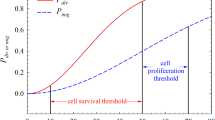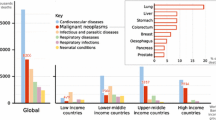Abstract
A mathematical model of tumor growth has been developed that takes angiogenesis into account. Malignant cells under metabolic stress produce vascular endothelial growth factor, which stimulates angiogenesis and, thus, increases nutrient influx into a tumor. The model takes into account migration-proliferation dichotomy in malignant cells that depends on the nutrient concentration. Convective fluxes that occur upon active tumor-cell proliferation in a compact dense tissue have been also considered. The computational investigation of the model demonstrated that the diffusive tumor growth rate does not depend on angiogenesis, while for noninvasive tumors angiogenesis could significantly alter tumor growth, although it is not able to stop it completely. The causes and significance of the results for the estimation of the antitumor efficacy of antiangiogenic therapy are discussed.
Similar content being viewed by others
Abbreviations
- AAT:
-
antitumor antiangiogenic therapy
- VEGF:
-
vascular endothelial growth factor
References
J. Folkman, P. Cole, and S. Zimmerman, Ann. Surg. 164, 491 (1966).
J. Folkman, N. Engl. J. Med. 285, 1182 (1971).
T. H. Adaír and J.-P. Montani, Angiogenesis, Ed. by J. Granger and D. N. Granger, in Morgan and Claypool Life Sciences Series (San Rafael, 2011).
M. A. Konerding, C. van Ackern, and E. Fait, in Blood Péfusion and Microenvironment of Human Tumors: Implications for Clinical Radiooncology, Ed. by M. Molls and P. Vaupel (Springer, Berlin, 2002), pp. 5–17.
M. Welter, K. Bartha, and H. Rieger, J. Theor. Biol. 259, 405 (2009).
T. Deng, L. Zhang, X.-J. Liu, et al., Med. Oncol. 30 (4), (2013).
G. Dranitsaris, N. Beegle, A. Ravelo, et al., Clin. Lung Cancer 14 (2), 120 (2013).
M. Nishino, A. Giobbie-Hurder, N. H. Ramaiya, and F. S. Hodi, J. Immunother. Cancer 2 (1), (2014).
J. Wang, L. Zhang, C. Jing, et al., Theor. Biol. Med. Model. 10 (2013).
M. Welter, K. Bartha, and H. Rieger, J. Theor. Biol. 250, 257 (2007).
N. V. Mantzaris, S. Webb, and H. G. Othmer, J. Math. Biol. 49, 111 (2004).
A. Stephanou, S. R. McDougall, A. R. A. Anderson, and M. A. J. Chaplain, Math. Comput. Model. 44, 96 (2006).
M. C. Eisenberg, Y. Kim, R. Li, et al., Proc. Natl. Acad. Sci. U. S. A. 180 (50), 20078 (2011).
P. Hinov, P. Gerlee, L. J. McCavley, et al., Math. Biosci. Eng. 6, 521 (2009).
K. R. Svanson, R. C. Rockne, J. Claridge, et al., Cancer Res., 71, 7366 (2011).
B. Szomolay, T. D. Eubank, R. D. Roberts, et al., J. Theor. Biol. 303, 141 (2012).
M. Welter and H. Rieger, Eur. Phys. J. E 33, 149 (2010).
F. Spill, P. Guerrero, T. Alarcon, et al., J. Math. Biol. (2014).
A. V. Kolobov and M. B. Kuznetsov, Russ. J. Num. Anal. Math. Model. 28 (5), 471 (2013).
S. K. Stamatelos, E. Kima, A. P. Pathak, and A. S. Popel, Microvasc. Res. 91, 8 (2014).
A. V. Kolobov, A. A. Polezhaev, and G. I. Solyanyk, in Mathematical Modelling and Computing in Biology and Medicine, Ed. by V. Capasso (2003), pp. 603–609.
A. V. Kolobov, V. V. Gubernov, and A. A. Polezhaev, Math. Model. Nat. Phenom. 6 (7), 27 (2011).
A. Giese, R. Bjerkvig, M. E. Berens, and M. Westphal, J. Clin. Oncol. 21, 1624 (2003).
A. V. Gusev and A. A. Polejaev, Int J. Biochem. Cell Biol. 30 (11), 1169 (1998).
O. N. Pyaskovskaya, D. L. Kolesnik, A. V. Kolobov, et al., Exp. Oncol. 30, 269 (2008).
J. J. Casciari, S. V. Sotirchos, and R. M. Sutherland, Cell Prolif. 25, 1 (1992).
M. Xiu, S. M. Turner, R. Busch, et al., FASEB J. 20 (Meet. Abstr. Suppl.), A718 (2006).
F. Milde, M. Bergdorf and P. Koumoutsakos, Biophys. J. 95, 3146 (2008).
A. H. Ko, A. P. Venook, E. K. Bergsland, et al., Cancer Chemother. Pharmacol. 66 (6), 1051 (2010).
S. Takano, E. Ishikava, K. Nakai, et al., OncoTargets and Therapy, 7, 1551 (2014).
Author information
Authors and Affiliations
Corresponding author
Additional information
Original Russian Text © A.V. Kolobov, M.B. Kuznetsov, 2015, published in Biofizika, 2015, Vol. 60, No. 3, pp. 555–563.
Rights and permissions
About this article
Cite this article
Kolobov, A.V., Kuznetsov, M.B. Investigation of the effects of angiogenesis on tumor growth using a mathematical model. BIOPHYSICS 60, 449–456 (2015). https://doi.org/10.1134/S0006350915030082
Received:
Published:
Issue Date:
DOI: https://doi.org/10.1134/S0006350915030082




